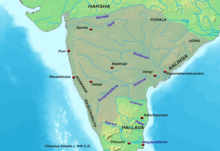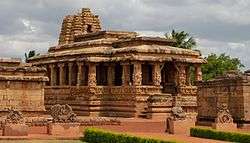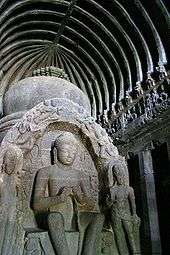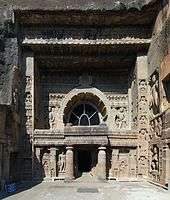Aihole
| Aihole ಐಹೊಳೆ | |
|---|---|
| village | |
|
Group of monuments At Aihole | |
 Aihole  Aihole | |
| Coordinates: 16°1′08″N 75°52′55″E / 16.01889°N 75.88194°ECoordinates: 16°1′08″N 75°52′55″E / 16.01889°N 75.88194°E | |
| Country | India |
| State | Karnataka |
| District | Bagalkot |
| Languages | |
| • Official | Kannada |
| Time zone | IST (UTC+5:30) |
| Nearest city | Pattadkal |
Aihoḷe is a village having a historic temple complex in the Bagalkot district of Karnataka, India and located 510 km from Bangalore. It is known for Chalukyan architecture, with about 125 stone temples dating from 5th century CE, and is a popular tourist spot in north Karnataka. It lies to the east of Pattadakal, along the Malaprabha River, while Badami is to the west of both. With its collection of architectural structures, Aihoḷe temple complex is on the pending list of UNESCO World heritage sites.[1]
History
Aihoḷe was earlier known as Ayyavoḷe and Aryapura in its inscriptions.[2] It was established in 450 CE as first capital of Chalukya kings and has about 125 stone temples, some which were constructed as experimental structures by artisans of Chalukyan period.[3] A place known by as Morera Angadigalu near the Meguti hillocks has a large number of cysts of pre-historic period. The place was an agraharam. Aihoḷe has been described as a cradle of temple architecture. Some brick structures of pre-Chalukyan times have also been excavated in this village.

_at_the_Lad_Khan_temple_in_Aihole.jpg)
Aihole has historical significance and is called the 'cradle of Hindu rock architecture' (cradle of Indian architecture).[4]
Pulakeshin I, one of the greatest rulers of this dynasty, moved the capital to Badami nearby. Badami was then known as Vatapi. It is from these temples that the Chalukyas gained their experience and went on to build the great temples of Pattadakal.
The first phase of temple building in Aihole dates back to the fifth–sixth century,[5][6] the second phase up to the 12th century CE.
Important temples at Aihole
- Durga temple complex
- Lad Khan Temple
- Ambigera Gudi complex
- Mallikarjuna temple complex
- Chikki temple
- Rachi temple
- Eniyar temples complex
- Hucchimalli temple complex
- Ravanaphadi rock-cut temple
- Jain temple, Meguti temple
- Hucchappayya Math Complex
- Kunti temples complex
- Jain temple, Charantimath complex
- Tryambakesvara group
- Gauri temple
- Jaina temples in the village
- Rock-cut Jain Basadi
- Ramlingesvara Temple Complex
- Galaganatha Temple Complex
Aihole inscription

The famous Badami Chalukyas King Pulakeshin II (610–642 A.D.) was a follower of Vaishnavism. The inscription of Ravikirti, his court poet, is a eulogy of the Pulakeshin II and is at the Meguti temple. It is dated 634 CE and is written in Sanskrit language and old Kannada script. The Aihole inscription describes the achievements of Pulakeshin II and his victory against King Harshavardhana.[7] Aihole inscription of Pulakeshin II mentioned as akrantatma-balonnatim Pallavanam patim: that means the Pallavas had attempted to nip in the bud the rise of the Badami Chalukyas: The conflict of the two powers before the campaign of Pulakeshin II against the Pallavas. Inscription which prepared by Pulakeshin II (634 AD) found in the Jain Temple at Aihole, that all the scholars have relied on this inscription related to Mahabharata War and Kaliyuga.[8] In the Aihole inscription referred that Mangalesha's (Paramabhagavat) victory over the Kalachuris and the conquest of Revatidvipa. According to the Aihole inscription of Pulakeshin II, a civil war between Mangalesha and Pulakeshin II, due to Mangalesha's attempt to secure the succession for his son, which was the end of Mangalesha's reign.[9] In inscription of Amoghavarsha I found at Aihole, mentioned about his new administration (navarajyam geyye).[10]
Early Chalukya style of architecture

_in_the_Ravana_padhi_cave_temple_in_Aihole.jpg)
Aihole was the cradle of ancient Hindu temple architecture.[11] It has more than 70 temples. Experimentation with styles was undertaken by the artisans. The artisans worked on the rocks to create the earliest rock-cut shrines.[12] The artisans graduated to the full-fledged Chalukya style of architecture.
The early Chalukyas inherited architectural styles largely from their neighbors to the north and south of their kingdom.[13] Usage of curved towers decorated with blind arches came from northern India. Plastered walls with panel inserts are a southern Indian style. The usage of Deccan style is in their balcony seating, angled eaves and sloping roofs, and elaborately carved columns and ceilings (George Michell,1997). In short, they artistically brought together the prevailing styles in their neighbourhood to create the Chalukya style.
Typical features unique to Badami Chalukyas architecture include mortarless assembly, an emphasis on length rather than width or height, flat roofs, richly carved ceilings, and, sculpturally, an emphasis on relatively few major figures, which tend to be isolated from each other rather than arranged in crowded groups. The aesthetic sensibility of sculpture from this period also seems to retain a certain classical quality whose impulse does not carry over into later periods of Indian art (Susan Huntington, 1985).
The Temples
Three temples are referred to as the 'Kontigudi group of temples'. One of these is the Lad Khan temple (the oldest at Aihole is the Lad khan temple dating back to the fifth century[11]), named after a mendicant that lived in this temple in the 19th century, another the Huchiappayyagudi temple and the Huchiappayya math.
Hindu Temple







The prominent temple groups at Aihole are the Kontigudi group and the Galaganatha group of temples, although historians have divided all the temples into 22 groups.
- Durga temple or fortress temple is the best known of the Aihole temples and is very photogenic. It is apsidal in plan, along the lines of a Buddhist chaitya, a high moulded adisthana and a tower – curvilinear shikhara. A pillared corridor runs around the temple, enveloping the shrine, the mukhamantapa and the sabhamantapa. All through the temple, there are beautiful carvings. The temple appears to be of the late 7th or early 8th century. The Museum and Art Gallery is a sculpture gallery maintained by the Archaeological Survey of India in the Durga Temple complex which opens from Saturday to Thursday.
- Lad Khan Temple[14] consists of a shrine with two mantapas in front of it. The shrine bears a Shiva lingam. The mukha mantapa in front of the sanctum has a set of 12 carved pillars. The sabhamantapa in front of the mukha mantapa has pillars arranged in such a manner as to form two concentric squares. There are also stone grids on the wall carrying floral designs. The temple is built in a Panchayat hall style, indicating a very early experiment in temple construction. The windows are filled with lattice style which is a north Indian style. The temple was built by the Chalukya kings in the 5th century. Ladkhan Temple is to the south of the Durga temple are the temples of this group. The Ladkhan temple, so named, as a general of the name had lived here, consists of a square mantapa, a mukha mantapa and the sanctum, built against the backwall. The west, south and north walls have beautifully carved stone lattices. On the lintel of the sanctum is a garuda image and in the shrine a Shivalinga. The central square has a flat roof. In the centre Nandi is installed, and just above Nandi, there is a damaged nagara shikhara, appearing to be a later addition. The period of this structure is about 450 A.D.
- Ravana Phadi cave is one of the oldest rock cut temples in Aihole; it is southeast of Hucchimalli temple. This temple dates back to the 6th century, with a rectangular shrine, with two mantapas. There is a Shivalinga in the inner room or sanctum sanctorum. This is a Shaivite cave temple with a sanctum larger than that of the Badami Cave Temples. The sanctum has a vestibule with a triple entrance and has carved pillars. The walls and sides of the temple are covered with large figures including dancing Shiva. Ravalphadi Vedic rock-cut shrine is the most famous of the three rock-cut shrines at Aihole, located to the south-east of Huchimalli group of temples, dedicated to Shiva. Assigned to the sixth century, this rock-cut shrine has a fine figure of Nataraja dancing, surrounded by Saptamatrikas, all engraved in bold relief and in elegant styles. The
- Jyothirlinga Group, at a short distance to the southwest of Ravalaphadi, is the group of temples called Jothirlinga group. Two small temples here are flat roofed and in front of them are Nandimantapas. The remaining temples have a sanctum, shukanasa and a front hall in each of the temples. Two of the temples have Kadambanagara towers. Two of the temples have inscriptions of the Kalyana Chalukya period. The rest of the temples now dilapidated are of about the 8th to 10th centuries.
- Huchappayya (gudi) temple has a curvilinear tower (shikhara) over the sanctum (unlike the Lad Khan temple). The interior of the temple has beautiful carvings. The Huchappayana Temple Located to the south of Aihole fort, on the way to the Malaprabha river, this Shiva temple has a mukhamantapa, a hall and the sanctum, adored with a Rekhanagara shikhara. There are several big square pillars in the porch and hall. Pillars of the porch have finely carved figures of couples, and on the ceiling a fine Nataraja image. Exterior walls of the sanctum have three niches with Narasimha. This temple was constructed in about 8th century A.D.
- Group of Yeniar Shrines, a little further away to the south, along the river bank are this group of eight temples, usually with a porch, hall and a cella, all of about 12th century
- Ramalinga group of temples lies to the south of Yeniar shrines. Chief shrine among this group is Ramalinga. In this trikutachala shrine two cells have Shivalinga and the third, the image of Parvati. Period of this trikutachala is about the 11th century A.D. Facing westward, the shrine has two Kadambanagara towers. The place has a small mosque. (Source: Karnataka State Gazetteer 1983)
- Galaganatha group of temples is one of nearly thirty temples on the bank of the Malaprabha River. The main shrine of the Galaganatha temple enshrining Shiva – Galaganatha has a curvilinear shikhara, and has images of Ganga and Yamuna at the entrance to this shrine. Galaganatha group of temples, further south of Huchappaiah temple is this group of about 38 small shrines in which the shrine of Galaganatha is intact, and most of the others are in ruins. The Galaganatha shrine has a hall, interior passage and sanctum. Its tower is rekhanagara. The temple has been assigned to the 8th century. There is another 10th century trikutachala temple found in this group.
- Suryanarayana temple has a 0.6 m high statue of Surya along with his consorts Usha and Sandhya being drawn by horses. The temple dates from the 7th or 8th century, has a four pillared inner sanctum and a nagara style tower over it. Suryanarayana Gudi is to the northeast of Ladkhan temple. It has a four pillared inner hall and in the sanctum, two feet tall idol of Surya. Over the sanctum is a rekhanagara tower. This has been assigned to the 7th−8th centuries.
- Chakra Gudi is a little further to the south from Ladkhan group with a hall and sanctum. Its tower is in rekhanagara style. Its period is about the 9th century.
- Badigera gudi is to the west of Chakragudi which was originally a Surya temple, which has a porch, hall and a cell shrine and over it a rekhanagara tower. The temple belongs to the 9th century.
- Ambigera Gudi Group is situated to the west of the Durga temple outside the fort, there are three temples of this group. The biggest among them has a rekhanagara tower. It is supposed to be 10th century structure.
- Chikkigudi Group is at a short distance to the north of the Ambigeragudi are a group of temples among which Chikkigudi is the biggest with a front hall, a mantapa and a cell shrine. This is supposed to be a 7th-century structure.
- Huchimalli (gudi) temple at Aihole, built in the 7th century shows an evolution in the temple plan, as it shows an ardhamantapa or an ante-chamber annexed to the main shrine. Huchimalli Group Of Temples, to the north of the village behind the travelers’ bungalow is this beautiful temple. The sanctum here has a pradakshinapatha and its external walls contain lattices. The sanctum has a northern style rekhanagara tower. It is in this temple the shukanasa or the vestibule was introduced for the first time. A little away in front is another dilapidated temple. Another small temple to the north of Huchimalligudi is assigned to the 11th century.
- Gaudara gudi is very close to the Ladkhan temple, built on the lines of Ladkhan temple. It is standing on high molded base. An outer wall contains 16 pillars. Between them, stone slabs are fixed to serve as walls. An 8th-century inscription here refers to this as Bhagavati temple. To the north of the Jaina temples is the Gowri temple. It is in Kalyana Chalukya style assignable to the 12th century.
- Rachi gudi lies to the west of the village. It is a trikutachala Shiva temple constructed in about 11th century. It stands on a high plinth, faces west and the three cells face three directions. On the external walls of the temple are small niches with Ganapathi, Nataraja and Vishnu images.
- Huchappayya Matha is towards west of the village is this matha, and closely is a temple. This temple includes a hall, and a sanctum. On the ceiling are the trimurti figures. Here is an inscription of 1067 A.D.
- Halabasappana Gudi is to the west of the village. It is a small structure with a sanctum and a hall. At the entrance, on the door frame are engraved the idols of Ganga and Yamuna.
- Kontigudi group of temples, situated in about the middle of the bazaar are four temples. The first among them has the Trimurthy idols on the ceiling of the mantapa. These temples are assignable to the 7th century with various adjuncts being added during later centuries. Only one among them is dilapidated, and is of about the 10th century.
- Triyambakeshvara Group is close to the Charantimatha, towards northeast two of which are trikutachalas, assigned to the 12th century. Nearby is Maddina gudi. There is an idol of nataraja in the mantapa and this is an 11th-century AD temple.
Jain Temples
- Meguti Jain temple stands on a hillock. It is the only dated monument built in 634. The temple is dedicated to Mahavira, the 24th tirthankara.[15] The temple sits on a raised platform, and a flight of steps leads one to the mukhamantapa. The pillared mukhamantapa is a large one. A flight of stairs leads to another shrine on the roof, directly above the main shrine. From the roof, one can have a panoramic view of the plain with a hundred temples or so. The temple which was possibly never completed gives important evidence of early development in dravidian style of architecture. The dated inscription found on the outer wall of the temple records the construction of the temple by Ravikeerthi, a scholar in the court of emperor Pulakeshin II. In the Meganagudi group of temples, there are several ancient temples on Megutigudda, a small hillock to the southeast of the village. A two-storeyed structure here has a natural cavern inside. The first floor includes a pillared hall, and at the wall behind it are three cells. The central room is the shrine cell, the second floor similarly has a verandah and a square cell behind. This is an ordinary structure and is assigned to the 5th century. The Meguti or the Meganagudi is a Jinalaya in the Dravidian style enclosed by a stone wall. It has a pillared hall in front, and antarala and the sanctum behind, with pradakshinapatha. On one of the outer walls is found the famous Aihole inscription dated 634 A.D. recording the construction of the Jinendra temple by Ravikeerti, who was a commander and minister of Pulakeshin II. The record makes a mention of Kalidasa and Bharavi and is composed in an ornate style in Samskrita by Ravikirti himself. To the south-east of Meguti is a small Jaina cave, which has a porch, a wall behind and a sanctum in the back which houses a five-foot tall-Bahubali figure and other Tirthankaras are also engraved in other parts against walls.
- Charanthimatha Group of temples, very close to the Kontigudi group, to the north east is group of Jaina temples. In course of time they came under the control of one Charantimatha and hence the present name. The chief among these is trikutachala, and a hall connects the three shrines with a portico in front. It is about 11th −12th century A.D., built in the Kalyana Chalukya style. There is a twin basadi with one porch serving both, with each housing 12 Tirthankars. An inscription here records the date of construction as 1120 A.D.
- Jain cave temple is at the entrance of the Aihole (from Pattadakal/Badami) on the banks of Mallaprabha river; it is similar to Ravana Phadi cave. There are inscriptions on rock in old Kannada near the cave.
- Scattered in the pre historic period meghalithic site behind the Meguti temple are many dolmens, numbering about 45 and more are destroyed by treasure hunters. Local people call it Morera mane (Morera tatte) or Desaira Mane. Each dolmen has three sides upright square slabs and large flat slab on top forms roof, front side upright slab had circular hole.
Buddhist Temple
- Buddhist Cave
Enrute to Meguti temple on same hill top there is 6th century two-storied Buddhist Cave temple which partly rock-cut structure. .
Gallery
| Photo Gallery |
|---|
|
See also
References
- ↑ "Evolution of Temple Architecture – Aihole-Badami- Pattadakal". UNESCO. 2004. Retrieved 21 October 2015.
- ↑ Encyclopaedia of the Hindu world, Volume 1 By Gaṅgā Rām Garg page 251
- ↑ Raghavan, Vikram K (13 May 2010). "Surviving the test of time". Retrieved 31 March 2014.
- ↑ "Aihole's stories in stone". Retrieved 2011-07-28.
- ↑ Sigfried J. de Laet and Joachim Herrmann, History of Humanity: From the seventh century B.C. to the seventh century A.D.. UNESCO, 1996.
- ↑ Reshma Rai, An Introduction of Naga, in Rajagriha
- ↑ "Message with Long Life: Indian Inscriptions". Dr. Jyotsna Kamat. Retrieved 2009-05-05.
- ↑ "The Scientific Dating of the Mahabharat War, Aihole Inscription". Dr.P.V.Vartak. Archived from the original on 16 April 2009. Retrieved 2009-05-05.
- ↑ "EARLY CHALUKYAS". Archived from the original on 10 April 2009. Retrieved 2009-05-05.
- ↑ "Bombay-Karnataka Inscriptions, Volume I – Part I, Introduction". Retrieved 2009-05-05.
- 1 2 "Echoes from Chalukya caves". Retrieved 2009-04-01.
- ↑ "ARCHITECTURE, The Chalukyan magnificence". Archived from the original on 10 May 2009. Retrieved 2009-04-01.
- ↑ Monuments of India, Part II, Early Chalukya, Aihole
- ↑ "Aihole, Lad Khan Temple". Retrieved 2009-04-01.
- ↑ http://www.jainglory.com/research/meguti
13.Karnataka State Gazetteer 1983.
External links
| Wikivoyage has a travel guide for Aihole. |
| Wikimedia Commons has media related to Aihole. |
- Aihole temples
- Photos of Aihole temples
- Official site of Bagalkot District
- Aihole group of temples on Google Maps
- Aihole Galaganatha and Ramalingeshwara group of temples on Google Maps
- Sacred Landscapes in Early Medieval South India: the Chalukya state and society (ca. AD 550-750) - Aihole
- Photos of Aihole British Library Collection

















_at_Aihole.jpg)




